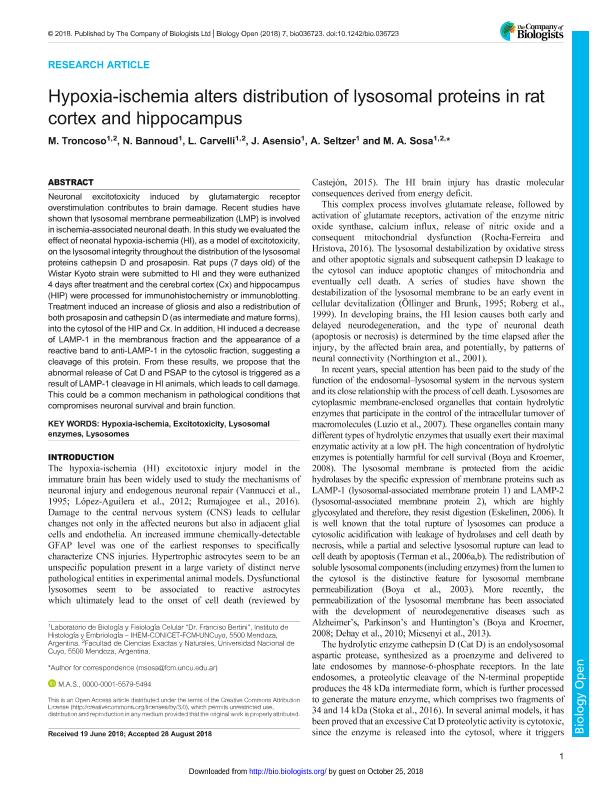Artículo
Hypoxia-ischemia alters distribution of lysosomal proteins in rat cortex and hippocampus
Troncoso, Mariana Elizabeth ; Bannoud, Nadia
; Bannoud, Nadia ; Carvelli, Flavia Lorena
; Carvelli, Flavia Lorena ; Asensio, Joana Antonela
; Asensio, Joana Antonela ; Seltzer, Alicia Mabel
; Seltzer, Alicia Mabel ; Sosa Escudero, Miguel Angel
; Sosa Escudero, Miguel Angel
 ; Bannoud, Nadia
; Bannoud, Nadia ; Carvelli, Flavia Lorena
; Carvelli, Flavia Lorena ; Asensio, Joana Antonela
; Asensio, Joana Antonela ; Seltzer, Alicia Mabel
; Seltzer, Alicia Mabel ; Sosa Escudero, Miguel Angel
; Sosa Escudero, Miguel Angel
Fecha de publicación:
25/10/2018
Editorial:
Company of Biologists
Revista:
Biology Open
ISSN:
2046-6390
Idioma:
Inglés
Tipo de recurso:
Artículo publicado
Clasificación temática:
Resumen
Neuronal excitotoxicity induced by glutamatergic receptor overstimulation contributes to brain damage. Recent studies have shown that lysosomal membrane permeabilization (LMP) is involved in ischemia-associated neuronal death. In this study we evaluated the effect of neonatal hypoxia-ischemia (HI), as a model of excitotoxicity, on the lysosomal integrity throughout the distribution of the lysosomal proteins cathepsin D and prosaposin. Rat pups (7 days old) of the Wistar Kyoto strain were submitted to HI and they were euthanized 4 days after treatment and the cerebral cortex (Cx) and hippocampus (HIP) were processed for immunohistochemistry or immunoblotting. Treatment induced an increase of gliosis and also a redistribution of both prosaposin and cathepsin D (as intermediate and mature forms), into the cytosol of the HIP and Cx. In addition, HI induced a decrease of LAMP-1 in the membranous fraction and the appearance of a reactive band to anti-LAMP-1 in the cytosolic fraction, suggesting a cleavage of this protein. From these results, we propose that the abnormal release of Cat D and PSAP to the cytosol is triggered as a result of LAMP-1 cleavage in HI animals, which leads to cell damage. This could be a common mechanism in pathological conditions that compromises neuronal survival and brain function.
Palabras clave:
EXCITOTOXICITY
,
HYPOXIA-ISCHEMIA
,
LYSOSOMAL ENZYMES
,
LYSOSOMES
Archivos asociados
Licencia
Identificadores
Colecciones
Articulos(IHEM)
Articulos de INST. HISTOLOGIA Y EMBRIOLOGIA DE MEND DR.M.BURGOS
Articulos de INST. HISTOLOGIA Y EMBRIOLOGIA DE MEND DR.M.BURGOS
Articulos(IMBECU)
Articulos de INST. DE MEDICINA Y BIO. EXP. DE CUYO
Articulos de INST. DE MEDICINA Y BIO. EXP. DE CUYO
Citación
Troncoso, Mariana Elizabeth; Bannoud, Nadia; Carvelli, Flavia Lorena; Asensio, Joana Antonela; Seltzer, Alicia Mabel; et al.; Hypoxia-ischemia alters distribution of lysosomal proteins in rat cortex and hippocampus; Company of Biologists; Biology Open; 7; 10; 25-10-2018; 1-8
Compartir
Altmétricas



